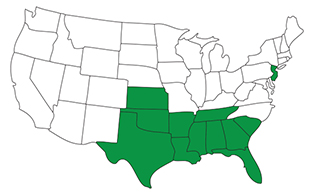
Surinam Sedge
Cyperus surinamensis
Surinam Sedge is a perennial grassy weed that is also known as Tropical Flatsedge or by its scientific name, Cyperus surinamensis. While there is a difference between grass and sedge, when it comes to unwanted lawn weeds, getting rid of them is what really matters.
Identify

Rhizomes

Sedge
Surinam Sedge can be identified as a perennial grassy weed with a triangular stem. The stem includes downward-curving prickles and is rough to the touch when rubbed upward. There are a few long leaves at the top of the stem, which is located under the seed head. The seed head consists of numerous tightly congested clusters of spikes on long stalks. Surinam Sedge flowers from late spring until the first frost. Reproduction of this lawn weed is carried out by seeds.
Life Cycle
These lawn weeds prefer moist to wet areas and are often found growing in ditches, marshes and lawns. Surinam Sedge can be found throughout the American Southeast and as far northwest as Kansas. These perennial grassy weeds can germinate and spread from seeds, but they also produce a root structure (tubers, bulbs or corms) that can birth new weeds from your lawn's surface (using stolons) or from underground (using rhizomes). Perennial grassy weeds live two or more years and have a deeper root structure that can give rise to new weeds—even if you no longer see the weeds in your lawn.

Control
Cultural weed control methods—such as hand-pulling lawn weeds or proper watering and mowing—are not recommended for removing Surinam Sedge if it has invaded your lawn or landscaping. For effective weed removal, professionally selected and applied weed control treatments are your best bet for eradication.







